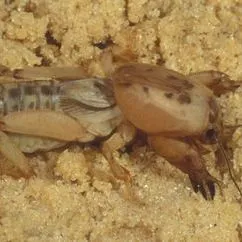Fryllotalpidae
Available Languages:
English
Narrower Topics
Mole crickets can become serious pests of turfgrasses, pastures, and vegetable seedlings. Three non-native species of mole crickets occur in Florida, including the tawny, southern, and shortwinged mole crickets. Adults are about 1 1/2 inch long, light brown, and have enlarged forelegs that they use to dig in soil. The forelegs have large blade-like projections, called dactyls, and the number and arrangement of dactyls, as well as the pronotum pattern (area behind the head), are used to identify different species. Nymphs look like adults, but their wings (wing pads) are not completely developed and they can't reproduce. Shortwinged mole cricket adults have short wings and cannot fly. Mole crickets damage turfgrass in several ways. Nymphs and adults feed on grass roots and blades at night after rain or irrigation, during warm weather. Their tunneling near the soil surface dislodges plants or causes them to dry out. Small mounds of soil are also pushed up by late summer. More than 20 feet of tunneling per night can occur. Tunneling and root-feeding reduce turfgrass density and create patches of bare soil.
